Connect With Us
Blog
Items filtered by date: January 2024
How Custom-Made Orthotics Can Help You
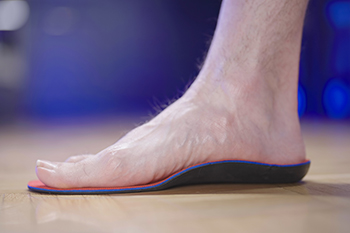
Custom-made orthotics are specialized devices designed to support and improve the function of the feet and lower limbs, offering a personalized solution for individuals with various lower limb problems. These devices are meticulously crafted based on an individual's unique foot structure and specific health needs, providing targeted support where it is most needed. They work by aligning the foot and ankle into their most anatomically efficient position, thereby alleviating stress and strain on the lower limbs. This tailored approach can significantly help in managing conditions such as flat feet, plantar fasciitis, bunions, and arthritis, as well as in alleviating discomfort caused by long periods of standing or walking. By improving foot mechanics, custom orthotics not only address immediate pain and discomfort but also aid in preventing future musculoskeletal issues. They are often recommended by podiatrists, as a key component in a comprehensive treatment plan for lower limb ailments. If you would like to learn how custom-made orthotics can help you, it is suggested that you make an appointment with a podiatrist today.
If you are experiencing discomfort in your feet and would like to try custom orthotics, contact Dr. Eddy Caldwell from Foot Care of Northeast Arkansas, P.A.. Our doctor can provide the care you need to keep you pain-free and on your feet.
What Are Custom Orthotics?
Custom orthotics are inserts you can place into your shoes to help with a variety of foot problems such as flat feet or foot pain. Orthotics provide relief and comfort for minor foot and heel pain.
Over-the-Counter Inserts
Shoe inserts come in a wide variety and are used to treat foot pain, heel pain, and minor problems. For example, arch supports can be inserted into your shoes to help correct overarched or flat feet, while gel insoles are often used because they provide comfort and relief from foot and heel pain by alleviating pressure.
Prescription Orthotics
If over-the-counter inserts don’t work for you or if you have a more severe foot concern, it is possible to have your podiatrist prescribe custom orthotics. These high-quality, custom inserts are designed to treat problems such as abnormal motion, plantar fasciitis, and severe forms of heel pain. They can even be used to help patients suffering from diabetes by treating foot ulcers and painful calluses and are usually molded to your feet individually, which allows them to provide full support and comfort.
If you're experiencing minor to severe foot or heel pain, it’s recommended to speak with your podiatrist about the possibility of using custom orthotics or shoe inserts. A podiatrist can determine which type of custom orthotic or shoe insert is right for you and help you take the first steps toward being pain-free.
If you have any questions please contact our office located in Jonesboro, AR . We offer the newest diagnostic and treatment technologies for all your foot and ankle needs.
Managing a Stubbed Toe
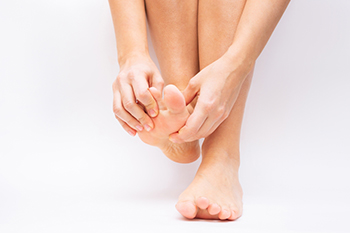
Managing a stubbed toe can be a surprisingly painful experience. Stubbing a toe often results from accidentally kicking the toe into a wall, tripping over objects, or catching it on various surfaces. The symptoms, whether the injury is minor or severe, typically include intense and sometimes sharp pain, radiating discomfort through the foot or ankle, and pain when putting weight on the injured area. The pain of stubbed toes can be significant because of the abundance of nerves in the toe. This heightened sensitivity is compounded by the lack of substantial cushioning in some shoes, along with minimal fat in the toe to absorb impact. This can increase the risk of more severe injuries, such as bone bruises and fractures. If the toe begins to swell and persistent pain lingers even after several hours, it is a sign you may need to see a podiatrist. Additionally, if the toenail either detaches, or the surrounding area experiences significant swelling, you may be at risk of an infection. For these reasons, it is suggested that you schedule an appointment with a podiatrist to ensure proper care and prevent potential complications.
Toe pain can disrupt your daily activities. If you have any concerns, contact Dr. Eddy Caldwell of Foot Care of Northeast Arkansas, P.A.. Our doctor can provide the care you need to keep you pain-free and on your feet.
What Causes Toe Pain?
Most severe toe pain is caused due to a sports injury, trauma from dropping something heavy on the toe, or bumping into something rigid. Other problems can develop over time for various reasons.
Toe pain can be caused by one or more ailments. The most common include:
- Trauma
- Sports injury
- Wearing shoes that are too tight
- Arthritis
- Gout
- Corns and calluses
- Hammertoe
- Bunions
- Blisters
- Ingrown toenails
- Sprains
- Fractures (broken bones)
- Dislocations
When to See a Podiatrist
- Severe pain
- Persistent pain that lasts more than a week
- Signs of infection
- Continued swelling
- Pain that prevents walking
Diagnosis
In many cases the cause of toe pain is obvious, but in others, a podiatrist may want to use more advanced methods to determine the problem. These can range from simple visual inspections and sensation tests to X-rays and MRI scans. Prior medical history, family medical history, and any recent physical traumatic events will all be taken into consideration for a proper diagnosis.
Treatment
Treatments for toe pain and injuries vary and may include shoe inserts, padding, taping, medicines, injections, and in some cases, surgery. If you believe that you have broken a toe, please see a podiatrist as soon as possible.
If you have any questions please feel free to contact our office located in Jonesboro, AR . We offer the newest diagnostic tools and technology to treat your foot and ankle needs.
Causes of Cuboid Syndrome
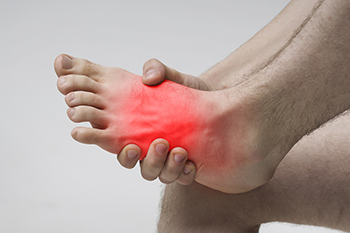
Cuboid syndrome is a condition resulting from joint and ligament injury surrounding the cuboid bone, one of the foot's seven tarsal bones. It causes lateral foot pain, often around the middle of the foot or at the base of the 4th and 5th toes. Diagnosis is challenging due to its non-specific symptoms and for that reason cuboid syndrome can be mistaken for stress fractures. A podiatrist will rely on a physical exam and medical history, as imaging may not always reveal cuboid syndrome. This condition occurs when the cuboid bone partially dislocates, typically due to sudden injury or overuse, common among athletes and dancers. Symptoms include lateral foot pain worsened by weight-bearing, limited mobility, and possible swelling. Causes include overuse, ankle sprains, pronated feet, rapid side-to-side movements, poorly fitting shoes, and inadequate rest. Treatment involves rest, elevation, compression and professional manipulations such as the cuboid whip or squeeze. If you have chronic foot pain, it is strongly suggested that you schedule an appointment with a podiatrist to uncover the cause and offer appropriate treatment.
Cuboid syndrome, also known as cuboid subluxation, occurs when the joints and ligaments near the cuboid bone in the foot become torn. If you have cuboid syndrome, consult with Dr. Eddy Caldwell from Foot Care of Northeast Arkansas, P.A.. Our doctor will assess your condition and provide you with quality foot and ankle treatment.
Cuboid syndrome is a common cause of lateral foot pain, which is pain on the outside of the foot. The condition may happen suddenly due to an ankle sprain, or it may develop slowly overtime from repetitive tension through the bone and surrounding structures.
Causes
The most common causes of cuboid syndrome include:
- Injury – The most common cause of this ailment is an ankle sprain.
- Repetitive Strain – Tension placed through the peroneus longus muscle from repetitive activities such as jumping and running may cause excessive traction on the bone causing it to sublux.
- Altered Foot Biomechanics – Most people suffering from cuboid subluxation have flat feet.
Symptoms
A common symptom of cuboid syndrome is pain along the outside of the foot which can be felt in the ankle and toes. This pain may create walking difficulties and may cause those with the condition to walk with a limp.
Diagnosis
Diagnosis of cuboid syndrome is often difficult, and it is often misdiagnosed. X-rays, MRIs and CT scans often fail to properly show the cuboid subluxation. Although there isn’t a specific test used to diagnose cuboid syndrome, your podiatrist will usually check if pain is felt while pressing firmly on the cuboid bone of your foot.
Treatment
Just as the range of causes varies widely, so do treatments. Some more common treatments are ice therapy, rest, exercise, taping, and orthotics.
If you have any questions, please feel free to contact our office located in Jonesboro, AR . We offer the newest diagnostic and treatment technologies for all your foot care needs.
Minimally Invasive Foot Surgery

Minimally invasive foot surgery offers several benefits for patients seeking relief from various foot conditions. First and foremost, it involves smaller incisions compared to traditional open surgery, resulting in less tissue damage, reduced scarring, and a quicker recovery period. Patients typically experience less pain and discomfort after the procedure, and they can often return to their regular activities sooner. Furthermore, minimally invasive techniques often lead to shorter hospital stays or even outpatient procedures, minimizing the overall healthcare costs and reducing the risk of hospital-acquired infections. These procedures are performed using advanced technologies such as endoscopes and specialized instruments, allowing for precise and targeted interventions. Minimally invasive foot surgery is versatile and can address a wide range of conditions, including bunions, hammertoes, plantar fasciitis, and neuromas. It offers the potential for improved cosmetic outcomes and better functional results compared to traditional surgery. Overall, this approach enhances patient satisfaction by offering effective treatment options with reduced pain, shorter recovery times, and improved quality of life. If you have a foot condition that requires surgery, it is suggested that you schedule an appointment with a podiatrist to discuss whether minimally invasive foot surgery is a good option for you.
Foot surgery is sometimes necessary to treat a foot ailment. To learn more, contact Dr. Eddy Caldwell of Foot Care of Northeast Arkansas, P.A.. Our doctor will assist you with all of your foot and ankle needs.
When Is Surgery Necessary?
Foot and ankle surgery is generally reserved for cases in which less invasive, conservative procedures have failed to alleviate the problem. Some of the cases in which surgery may be necessary include:
- Removing foot deformities like bunions and bone spurs
- Severe arthritis that has caused bone issues
- Cosmetic reconstruction
What Types of Surgery Are There?
The type of surgery you receive will depend on the nature of the problem you have. Some of the possible surgeries include:
- Bunionectomy for painful bunions
- Surgical fusion for realignment of bones
- Neuropathy decompression surgery to treat nerve damage
Benefits of Surgery
Although surgery is usually a last resort, it can provide more complete pain relief compared to non-surgical methods and may allow you to finally resume full activity.
Surgical techniques have also become increasingly sophisticated. Techniques like endoscopic surgery allow for smaller incisions and faster recovery times.
If you have any questions please feel free to contact our office located in Jonesboro, AR . We offer the newest diagnostic and treatment technologies for all your foot and ankle needs.
Wounds That Don't Heal Need to Be Checked
What Is a Diabetic Foot Ulcer?
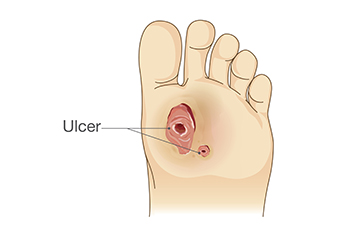
A diabetic foot ulcer is a significant and potentially serious complication arising from diabetes, characterized by open sores or wounds on the feet. The condition evolves due to a combination of factors associated with diabetes, such as impaired blood circulation, nerve damage, and compromised immune function. Elevated blood sugar levels contribute to reduced blood flow and sensation in the extremities, making the feet susceptible to injury. Minor cuts, blisters, or friction can escalate into non-healing ulcers due to the body's compromised ability to repair itself. What sets diabetic foot ulcers apart is their propensity for infection and slow healing, posing a heightened risk of severe complications if left untreated. Understanding the definition of diabetic foot ulcers underscores the importance of vigilant foot care, regular examinations, and proactive management strategies. If you have diabetes and have developed a diabetic foot ulcer, it is strongly suggested that you speak to a podiatrist who can guide you toward the best management and treatment strategies for this type of wound.
Wound care is an important part in dealing with diabetes. If you have diabetes and a foot wound or would like more information about wound care for diabetics, consult with Dr. Eddy Caldwell from Foot Care of Northeast Arkansas, P.A.. Our doctor will assess your condition and provide you with quality foot and ankle treatment.
What Is Wound Care?
Wound care is the practice of taking proper care of a wound. This can range from the smallest to the largest of wounds. While everyone can benefit from proper wound care, it is much more important for diabetics. Diabetics often suffer from poor blood circulation which causes wounds to heal much slower than they would in a non-diabetic.
What Is the Importance of Wound Care?
While it may not seem apparent with small ulcers on the foot, for diabetics, any size ulcer can become infected. Diabetics often also suffer from neuropathy, or nerve loss. This means they might not even feel when they have an ulcer on their foot. If the wound becomes severely infected, amputation may be necessary. Therefore, it is of the upmost importance to properly care for any and all foot wounds.
How to Care for Wounds
The best way to care for foot wounds is to prevent them. For diabetics, this means daily inspections of the feet for any signs of abnormalities or ulcers. It is also recommended to see a podiatrist several times a year for a foot inspection. If you do have an ulcer, run the wound under water to clear dirt from the wound; then apply antibiotic ointment to the wound and cover with a bandage. Bandages should be changed daily and keeping pressure off the wound is smart. It is advised to see a podiatrist, who can keep an eye on it.
If you have any questions, please feel free to contact our office located in Jonesboro, AR . We offer the newest diagnostic and treatment technologies for all your foot care needs.
Identifying Symptoms and Individuals Prone to Broken Toes
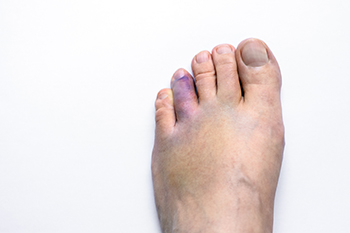
Broken toes, a common yet painful condition, can affect a range of individuals, each vulnerable in their unique ways. Those engaging in physically demanding activities, such as athletes or individuals with high-impact occupations, are at an elevated risk due to the increased likelihood of accidental trauma. Individuals with weakened bones, often associated with conditions like osteoporosis, also face higher susceptibility to fractures from minor injuries. Accidents at home, whether stubbing a toe against furniture or dropping a heavy object on it, pose a risk for anyone. Symptoms of a broken toe include immediate pain, swelling, and bruising, accompanied by difficulty moving the affected toe. Sometimes, a visible deformity or a cracking sound may accompany the injury. Recognizing these symptoms is vital for seeking prompt medical attention and ensuring proper care to facilitate optimal healing. If you have broken your toe, it is suggested that you visit a podiatrist as quickly as possible who can appropriately treat this condition.
A broken toe can be very painful and lead to complications if not properly fixed. If you have any concerns about your feet, contact Dr. Eddy Caldwell from Foot Care of Northeast Arkansas, P.A.. Our doctor will treat your foot and ankle needs.
What to Know About a Broken Toe
Although most people try to avoid foot trauma such as banging, stubbing, or dropping heavy objects on their feet, the unfortunate fact is that it is a common occurrence. Given the fact that toes are positioned in front of the feet, they typically sustain the brunt of such trauma. When trauma occurs to a toe, the result can be a painful break (fracture).
Symptoms of a Broken Toe
- Throbbing pain
- Swelling
- Bruising on the skin and toenail
- The inability to move the toe
- Toe appears crooked or disfigured
- Tingling or numbness in the toe
Generally, it is best to stay off of the injured toe with the affected foot elevated.
Severe toe fractures may be treated with a splint, cast, and in some cases, minor surgery. Due to its position and the pressure it endures with daily activity, future complications can occur if the big toe is not properly treated.
If you have any questions please feel free to contact our office located in Jonesboro, AR . We offer the newest diagnostic and treatment technologies for all your foot and ankle needs.






